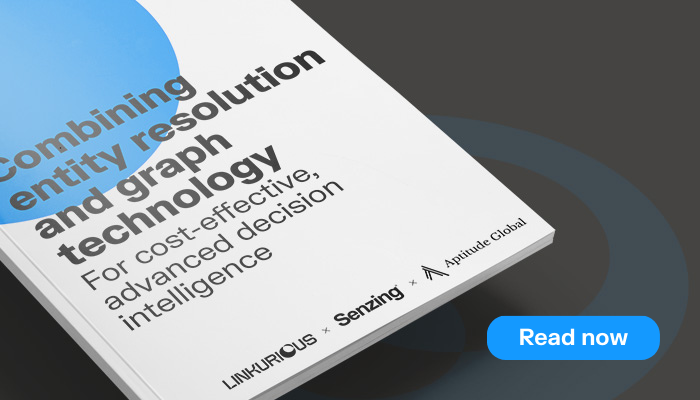Decision-makers navigating complex environments are finding traditional business intelligence tools falling short all too often. Their static reports and surface-level dashboards don’t offer the fast time-to-insight and predictive analysis that leaders need to thrive.
Enter decision intelligence. Decision intelligence uses AI and other technologies to turn data into clear, actionable insights that help leaders make better decisions. Rather than just showing what happened in the past, it provides real-time recommendations that speed up decision-making.
Gartner identified decision intelligence as one of the top technology trends for 2022, for good reason. While 8 in 10 organizations report that data is critical for their decision making, some 41% of business leaders lack a full understanding of their data due to its complexity or lack of accessibility.
Decision intelligence puts the power of complex data directly into the hands of decision makers. It turns what can seem an unmanageable asset into clear, actionable insights for charting the right path forward.
This article explores decision intelligence in depth - unpacking what it is, how it works, and how decision makers across industries can leverage it for risk management, competitive advantage, and more.

Decision intelligence is an emerging discipline that supports and improves decision making at every level within an organization - from high-level strategic decisions, to operational planning, to tactical execution on the front lines. It brings together both traditional business intelligence techniques and advanced disciplines such as predictive analytics using AI. It also uses entity resolution, network analytics, and collaboration technologies. The result is full context that assigns meaning and significance to data, in turn allowing for more accurate and better-informed choices for leaders.
Decision intelligence enables two complementary modes of decision making. On the one hand, it augments human intelligence to help people make faster decisions with confidence. On the other hand, it can also automate routine decisions based on the analytical models and decision frameworks it provides.
More and more organizations are seeing the value in decision intelligence. By 2030, McKinsey predicts that 70 per cent of businesses will be using it in some form.
Part of the power of decision intelligence lies in the way it centralizes data sources and contextual information. In de-siloing data, decision intelligence enables users to understand the key connections that point to patterns and relationships that may have previously been unknown or gone unseen. And it enables contextual intelligence by making the reasoning behind recommendations or insights transparent.
By creating this centralized, always up-to-date repository of decision-driving intelligence, it establishes a single source of truth that decision makers can rely on.
Ultimately, decision intelligence is about empowering decision makers to break down data barriers, connect the dots, and surface critical context, giving leaders the precise information they need to confidently decide on the right path forward.
Using data to inform decision making is not a new business practice. Organizations have turned to analytics and business intelligence tools for decades to extract value from their data.
But in today's context of rapidly evolving technology, shifting consumer behaviors, cyber threats, and global instability, being truly data-driven in decision making processes is more critical than ever before, even as it has become more challenging.
Today's organizations are faced with a paradox - they have more data at their fingertips than any previous generation, but making sense of it all and extracting insights of interest has perhaps never been more challenging. There is a constant influx of new data sources and exponential growth in the sheer volume of data.
Sorting through this overload of information, parsing out what is relevant and trustworthy, and seeing it in context can be a truly challenging process.
Traditional data analytics tools and business intelligence platforms often can’t meet the challenge. This is due to several factors:
- Traditional BI solutions rely on historical data, transforming them into business insights across dashboards. Because of the reliance on historical data, BI tools lack a predictive component.
- Often BI tools use limited datasets, leaving it up to decision makers to analyze information from multiple dashboards to try to draw conclusions. They run a strong risk of missing key connections.
- BI dashboards offer static insights and are unable to offer recommendations to decision makers. Their static nature also limits their ability to deliver timely insights.
These drawbacks leave room for a solution that better meets users’ needs.
Decision intelligence goes beyond traditional business intelligence to address the complex data challenges organizations face today. Here's why it's becoming essential:
Unlike previous generations of analytics tools, decision intelligence platforms can ingest and integrate all of an organization's data assets. They use advanced techniques like entity resolution and graph analytics to eliminate blind spots and create a complete, situational understanding for better decision-making.
Decision intelligence platforms deliver several key advantages:
- Reduced time to insight. By breaking down data silos, these platforms ensure decision makers receive dynamic, up-to-date information rather than static reports.
- Contextual recommendations. AI-powered predictive analytics provide actionable guidance tailored to specific business situations.
- Accelerated decision-making. The combination of integrated data and intelligent analysis significantly reduces the time needed to make critical business decisions.
Decision intelligence makes data-driven insights accessible to everyone, not just technical analysts. Front-line business users across all functions can easily access trusted, transparent data to make informed decisions in their daily workflows.
In our increasingly complex business environment, the ability to quickly make sense of data from multiple sources and perspectives has become a competitive advantage. Decision intelligence is the key to unlocking that power.
Decision intelligence provides organizations with a powerful new capability for managing risk and driving better business outcomes. By allowing them to finally maximize the value of their data assets, it unlocks a number of transformative benefits.
Traditional analytics tools often suffer from biases and blind spots baked into their algorithms and data models. Individual decision makers may also come with their own cognitive biases. Decision intelligence overcomes this by providing a unified, big picture view across all relevant data sources. It eliminates siloed perspectives and reduces the risk of inaccurate or skewed analysis. The insights are more comprehensive and more objective.
Advanced technologies like graph analytics and visualizations and AI allow decision intelligence platforms to automatically discover non-obvious yet potentially critical connections between disparate data points. These hidden patterns and relationships frequently contain key pieces of context that can alter decisions.
The ability to quickly analyze scenarios and model potential outcomes with decision intelligence leads to more informed decision making that mitigates risk. It helps organizations avoid costly mistakes from decisions based on incomplete information. Automation of routine decisions also drives better labor efficiency.
Furthermore, by unifying data and simplifying the process to gain insights and recommendations to drive better decision making, decision intelligence tools tend to offer a good return on investment.
By empowering both technical and non-technical users with data-driven insights, decision intelligence acts as a catalyst for organizational transformation. It breaks down silos, fosters collaboration, and creates a culture of using evidence to substantiate decisions and strategy.
For large enterprises with thousands or millions of daily operational decisions, decision intelligence provides the scale to efficiently and consistently apply data-driven reasoning across the board. It also allows for automated, AI-guided decision making.

A decision intelligence platform is designed to augment or automate decision making across the organization. It does this by providing the capabilities to ingest, unify, analyze, and derive insights from data sourced from multiple, disparate systems. While architectures can vary, there are several critical technology components that typically comprise a comprehensive decision intelligence solution.
A key first step is consolidating all relevant data assets into a central repository where they can be jointly processed and analyzed holistically. This involves ingesting and storing structured and unstructured data from databases, data lakes, SaaS applications, and other sources across the enterprise.
AI-based data enrichment extracts context and insights from unstructured sources like documents, images, and audio/video. The platform then combines and relates all these data elements into a unified view.
With a unified data foundation in place, the platform must establish a reliable, trustworthy source of truth that decision makers can depend on. This is achieved through entity resolution capabilities that intelligently resolve identities, relationships, and data conflicts across sources to create a complete and accurate profile for each entity of interest.
Understanding the full context surrounding data is critical for making informed decisions. Decision intelligence platforms should apply native graph technology that allows users to structure data as a network, visually mapping out how entities are connected and related to each other across multiple dimensions. This graph approach enables decision makers to interactively query the knowledge graph, analyze the context, identify patterns, and understand the bigger picture.
With context established, the real power of decision intelligence emerges through analytical capabilities. Using machine learning, statistical models, rules engines and other techniques, a decision intelligence platform can automatically generate insights, predictions, recommendations and alerts that guide real-world operational decisions. For ultra high-volume decision making use cases, decision flows can also be fully automated based on pre-defined strategies and parameters.
Finally, collaboration is a critical piece. Most platforms include workflow and teamwork tools that allow stakeholders across functions and roles to seamlessly communicate context, share insights, and collectively make decisions in a coordinated manner.

Organizations looking to adopt a decision intelligence platform are often met with two main options: a commercial packaged solution, or a modular solution combining multiple high-performing technology solutions. A commercial packaged solution can be very powerful and offer quick time to market, but they also come with certain drawbacks: high license and support costs, limited levels of customization, and they are difficult to replace if the commercial landscape changes.
A modular decision intelligence platform, on the other hand, can offer certain key advantages. They are highly flexible. A modular solution can start small and evolve iteratively. Components can be upgraded, replaced, or modified. Organizations can also manage costs by selecting components that match their budgets. It is also easier to evolve a modular solution should needs or commercial conditions change.
Decision intelligence platforms serve a wide range of business functions, from strategic planning to day-to-day operations. They're particularly valuable for roles and activities that require analyzing complex data to make time-sensitive decisions.
- Executive leadership. C-suite executives use decision intelligence to evaluate strategic options, assess market opportunities, and make high-stakes business decisions with greater confidence.
- Financial planning and analysis. Finance teams use these platforms to optimize budgets, forecast revenue, and identify cost-saving opportunities across the organization.
- Risk management. Risk analysts use decision intelligence to identify potential threats, assess their likelihood and impact, and develop mitigation strategies.
- Supply chain management. Operations managers use decision intelligence to predict demand, optimize inventory levels, and reduce supply chain disruptions.
- Marketing and sales strategy. Marketing teams apply these tools to segment customers, optimize campaign performance, and allocate resources to the highest-impact initiatives.
- Product development. Product managers use these platforms to prioritize features, understand customer needs, and make data-driven decisions about product roadmaps.
- Human resources. HR teams use decision intelligence for workforce planning, talent acquisition, and identifying factors that improve employee retention.
Decision intelligence has applications that span virtually every industry and domain. Here are some examples of how it can be applied across key sectors to drive better, data-driven decision making:
Decision intelligence can play a vital role in areas like risk management, fraud and money laundering detection, and regulatory compliance. By combining internal data like transactions, customer profiles, and market data with AI analytics, graph visualization, and automation, decision intelligence platforms allow financial institutions to:
- Perform holistic risk scoring on customers, transactions, etc. by analyzing the full context
- Detect hidden patterns and anomalous behavior that may signal fraud, money laundering or market manipulation
- Ensure rigorous compliance with quickly evolving regulatory requirements through automated monitoring
Supply chain leaders can use decision intelligence to increase operational efficiencies, minimize risk, develop contingency plans in the case of disruptive events, and optimize production and distribution networks. Unifying data across complex networks of suppliers, manufacturing, logistics, transportation and more into a contextual knowledge graph provides benefits like:
- Ability to model hypothetical scenarios and understand downstream impacts of disruptions or plan changes
- Automated monitoring and alerts for quality issues, fulfillment delays, sourcing risks or other threats
- Data-driven inventory planning, procurement optimization, and network design
- Predicting demand based on understanding economic conditions, consumer trends and market forces.
For national security, law enforcement and other public safety agencies, decision intelligence is an invaluable tool for threat detection, pattern recognition and predictive intelligence. Harnessing data from investigations, communications monitoring, crime databases and more, analysts can:
- Rapidly uncover hidden connections between individuals, locations, organizations and events of interest
- Visualize and explore data on dynamic maps, timelines and other intuitive context views
- Develop comprehensive threat models based on analyzing all contextual factors
- Enable collaborative analysis by streamlining data sharing and creating collective workflows
Decision intelligence helps governments at all levels make more informed policy decisions and deliver better public services. By breaking down data silos across agencies and tapping into a wide range of internal and external data sources, capabilities include:
- Using economic, demographic, public health and other data for comprehensive policy analysis and program planning
- Enabling data-driven resource allocation, budgeting and operational decisions across functions
- Improving service delivery through better understanding of constituent needs and intelligent process automation
- Detecting fraud, waste and abuse by uncovering hidden relationships across data sets
Across these diverse scenarios, decision intelligence serves as a "smart engine" that maximizes an organization's ability to put data into action in a consistent, trusted and automated manner. The insights surfaced allow leaders to navigate with confidence.
A critical piece of an effective decision intelligence platform is the ability to visually explore and understand the full context surrounding data entities and events of interest. Graph visualization and analytics are well positioned to play this role.
A graph data structure is designed to naturally represent the interconnected networks and relationships that exist in the real world. Graph databases map out these relationships, providing a model that reflects how individual data points like people, organizations, locations, transactions, etc. are connected with one another.
Graph analytics applies data science techniques specifically tailored for analyzing and deriving insights from graph data structures. This includes algorithms for community detection, centrality analysis, path finding, link prediction and more. Graph data science enables the identification of significant patterns, influencers, and anomalies within interconnected data in ways that are difficult or impossible with other data models.
By enriching decision intelligence solutions with advanced graph analytics capabilities, organizations gain a powerful lens for automating the contextual understanding and relational insights needed to guide decision making processes. Machine learning layered over graph representations can surface recommendations, predictive scoring, and situational awareness that would be lacking from traditional analysis methods.
In the context of decision intelligence, graph visualization enables leaders to gain visibility across data silos to extract insights and value from their data. They allow decision makers to not just view individual data elements, but to explore the web of relationships surrounding them across multiple dimensions - understanding how they fit into the bigger picture.
The capability to visualize context is key. Often the most critical pieces of information for effective decision making lie not in the data points themselves, but in the low-signal connections between them that may go unnoticed with more traditional analytics methods, such as those based on relational databases. Graph exploration tools enable decision-makers to quickly uncover such hidden, indirect links, patterns, and anomalies that can make or break strategy and operations.
High-performing decision intelligence platforms integrate user-friendly graph visualization and data exploration solutions designed to put this power into the hands of both technical and non-technical users across the organization. Linkurious’ technology provides an intuitive experience to navigate data interactively, enabling users to slice and dice the data according to their needs, to view it on a timeline or on a map, and more.
Linkurious Enterprise also enhances decision intelligence through features like:
- Advanced collaboration capabilities for teams to collectively analyze and annotate the data
- Automated graph alerting to proactively identify and flag anomalies, risks, or other elements of interest
Ultimately, natively incorporating graph visualization and exploration as part of a comprehensive decision intelligence tech stack empowers organizations to maximize insight extraction from their data assets. It transforms data into instantaneous context that can be understood and actioned upon at every level for driving more intelligent decisions.
Choosing the right tools for decision intelligence requires some forethought and understanding. Our recent white paper, published alongside Aptitude Global, a specialist data solutions provider, and Senzing, a leading software company providing entity resolution technology, dives into some of the challenges that come with de-siloing your data to manage risks and make more informed decisions. It also explores the question of how to choose between a commercial off the shelf solution and a modular technology solution.
